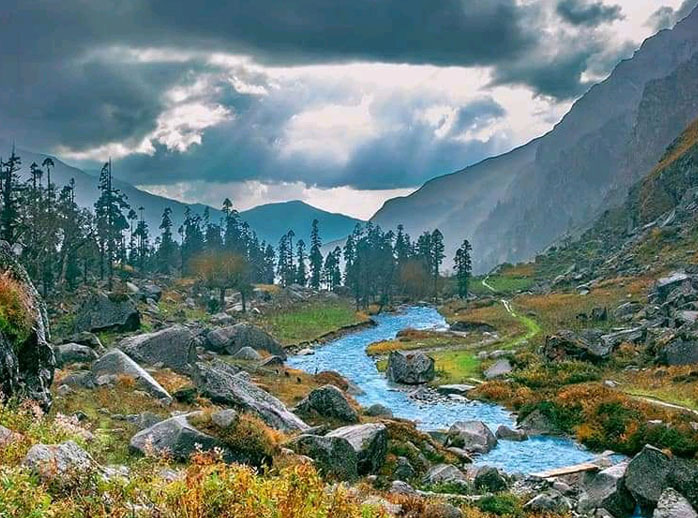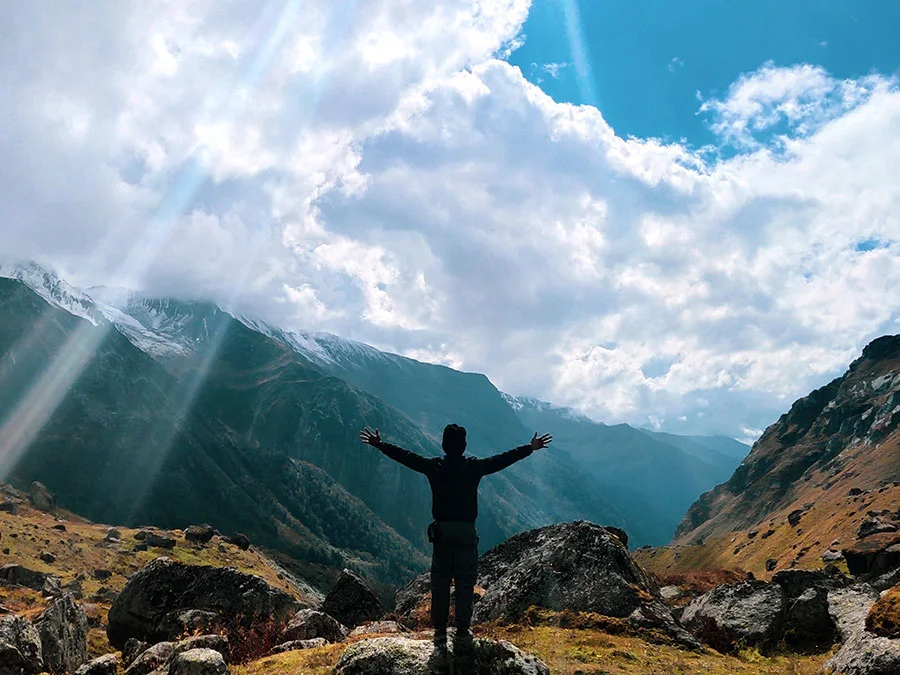The Har Ki Doon Trek is a classic trek in the Garhwal Himalayas, known as the “Valley of Gods” due to its mythological significance. Situated in the Govind Wildlife Sanctuary in Uttarakhand, the trail leads trekkers through ancient villages, alpine meadows, dense pine and oak forests, and ends at a stunning valley surrounded by towering peaks. The valley sits at an altitude of 11,675 feet (3,565 meters) and offers panoramic views of the Swargarohini and Bandarpoonch ranges.
This trek is popular among nature lovers, photographers, and adventure enthusiasts alike due to its rich biodiversity, crystal-clear streams, and cultural encounters in remote Himalayan villages. It’s also one of the few treks where you can witness both lush greenery and snow-capped peaks depending on the season.
Overview
- ocation: Garhwal Himalayas, Uttarakhand.
- Duration: 7 days (with 5 days of trekking).
- Difficulty Level: Moderate. Suitable for beginners with decent fitness levels and experienced trekkers.
- Highest Altitude: 11,675 feet (Har Ki Doon Valley).
- Total Trek Distance: Approximately 47-50 km.
- Best Time to Visit:
- Summer: April to June (clear skies, blooming flora).
- Autumn: September to November (crisp weather, perfect for views).
- Winter: December to March (for snow trekking).
- Starting Point: Sankri village, approximately 200 km from Dehradun.
Highlights
- Villages of Osla and Gangaad: Walk through these ancient villages, with traditional wooden houses and temples, experiencing the simple lifestyle of the locals. Rich Flora and Fauna: The trek passes through the Govind Pashu Vihar National Park, home to species like black bears, snow leopards, musk deer, and a variety of bird species. Swargarohini Peak Views: Mythologically significant, this peak is said to be the path to heaven that Pandavas took in the Mahabharata. Pristine Valley and Forests: Dense forests of pine, cedar, and oak line the trail, creating a serene atmosphere.
Itinerary
Package Includes
- Accommodation:
- 1-night stay in a guesthouse/hotel at Sankri (double/triple sharing rooms).
- Camping throughout the trek (twin/triple sharing tents).
- Meals:
- All meals during the trek (breakfast, lunch, dinner, snacks).
- Nutritious and well-planned vegetarian meals.
- Camping Equipment:
- High-quality 3-person tents.
- Sleeping bags with fleece liner for cold conditions.
- Sleeping mats for comfort.
- Toilet tents and kitchen/dining tents.
- Experienced Staff:
- Trek leader and professional guides with experience in the Har Ki Doon region.
- Porters and mules for carrying the group’s luggage (personal gear can be hired separately).
- Expert cook and support staff for all logistical requirements.
- Medical and Safety Equipment:
- First aid kit with essential medicines.
- Oxygen cylinders and oximeters for high-altitude acclimatization.
- Stretcher in case of emergencies.
- Permits and Entry Fees:
- Trek permits and forest entry fees for the Govind Wildlife Sanctuary.
- Transportation:
- Transport from Dehradun to Sankri and return in shared vehicles.
Package Excludes
- Personal Expenses:
- Personal items such as tips, laundry, extra food or drinks not included in the menu, or any purchases made during the trek.
- Personal Trekking Gear:
- Items like trekking poles, jackets, shoes, or personal backpacks are not provided.
- You may also need to rent certain gear like gaiters or microspikes in winter.
- Travel Insurance:
- Trekking insurance (covering accidents, high-altitude emergencies, and evacuation) is not included. It’s highly recommended to have travel insurance.
- Porter Charges for Personal Luggage:
- While porters/mules are provided for carrying camping and group equipment, carrying personal backpacks is not included. If needed, trekkers can hire porters at additional cost.
- Emergency Evacuation:
- While the staff is equipped with safety gear and first aid, any major evacuation (requiring helicopter or other advanced services) is not covered.
- Additional Accommodation:
- If there are any changes in the itinerary due to weather or personal preferences, extra stays at the base or midway are not covered in the package.
- Beverages and Bottled Water:
- Bottled water, soft drinks, and other beverages are not included. Trekkers will need to refill their bottles with fresh stream water or from campsite sources.
Best Time: The trek can be done in two major seasons:
- Summer/Pre-Monsoon: April to June (ideal for green landscapes, pleasant weather, and blooming flora).
- Post-Monsoon/Autumn: September to November (clear skies, ideal for photography, and stunning views of the surrounding peaks).
- Winter: December to March is great for experiencing the trek in snow, but it requires more preparation for cold conditions.
Difficulty: Har Ki Doon is rated as a moderate trek. While it’s suitable for beginners, some parts of the trail involve long walking hours (6-7 hours a day) and a gradual ascent. You need to have basic fitness to handle the trek comfortably.
Fitness: You don’t need to be an athlete to complete the trek, but a basic level of fitness is essential. You should be able to walk for 6-7 hours a day with a backpack. Some preparation tips include:
- Cardio exercises: Jogging, cycling, or swimming to build stamina.
- Leg Strength: Squats and lunges will help strengthen leg muscles.
- Walking Practice: Start long walks/hikes with your backpack before the trek.
- Summer: Pleasant weather during the day (15°C to 20°C), cooler at night (5°C to 10°C). Occasional rain showers might occur.
- Autumn: Crisp air, clear skies, daytime temperatures around 10°C to 15°C, and colder nights (0°C to 5°C).
- Winter: Cold temperatures with snow on the trail, daytime temperatures can be between 0°C to 5°C, and at night, temperatures drop to -5°C or lower.
- Guesthouse: The first night at Sankri will be in a guesthouse/lodge with basic amenities.
- Camping: For the rest of the trek, accommodation will be in tents on a twin/triple sharing basis. Comfortable sleeping bags, mats, and other camping essentials are provided.
Meals: Nutritious vegetarian meals are provided, including breakfast, lunch, dinner, and snacks. The food is simple, high in energy, and suitable for the high-altitude environment. Hot soup and ginger tea are served to keep trekkers warm.
A comprehensive packing list includes:
- Clothing:
- Thermals (top and bottom).
- Fleece jackets and windproof jackets.
- Waterproof trekking pants and regular trekking pants.
- Gloves, warm woolen socks, and caps.
- Raincoat or poncho.
- Trekking Gear:
- Sturdy trekking shoes with good grip.
- A 50-60 liter backpack.
- Walking stick/trekking pole.
- Other Essentials:
- Sunglasses, sunscreen, and lip balm.
- Water bottle or hydration pack.
- Personal toiletries and medications.
- Headlamp/torch with extra batteries.
Limited Connectivity: Mobile network coverage is available in Sankri and Taluka but becomes patchy and unreliable as you ascend. It’s better to inform family and friends about potential communication blackout during the trek.
The highest point of the Har Ki Doon trek is the Har Ki Doon Valley, located at an altitude of 11,675 feet (3,565 meters).
Permits: Yes, trekkers need entry permits for the Govind Wildlife Sanctuary. These are usually arranged by the trekking operator and included in the package cost.
Safety: A trek leader and experienced guides accompany the group, and the team is equipped with a first aid kit, oxygen cylinders, and an oximeter to monitor oxygen levels. The trekking team also ensures acclimatization through gradual ascents to prevent altitude sickness.
Dehradun to Sankri:
- The trek starts at Sankri, which is a 200 km drive from Dehradun (8-10 hours). You can reach Dehradun by flight or train from major Indian cities.
- From Dehradun, most trekking operators arrange shared transport to Sankri.
Group Size: Typically, the group size ranges from 5 to 20 trekkers. This ensures safety and allows for a more personalized experience with the guides and staff.
Yes, Har Ki Doon is considered a beginner-friendly trek with moderate difficulty. It does not require prior trekking experience but does require good physical fitness.
Toilet Tents: Temporary toilet tents are set up at each campsite. These are basic but clean and offer privacy. In the wilderness, proper hygiene and environmental care are maintained.
Yes, there is an option to hire mules/porters to carry personal backpacks for an additional fee. It’s recommended for those who may struggle with carrying weight over long distances.
In case of any medical emergency, the trek leader and support staff are equipped with oxygen cylinders, first aid, and stretchers. For severe cases, an evacuation plan is in place, but helicopter evacuation is not included in the package and is subject to availability and weather conditions.









